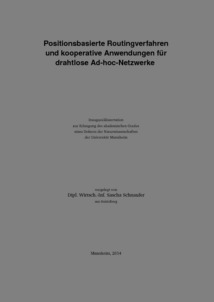|
Positionsbasierte Routingverfahren und kooperative Anwendungen für drahtlose Ad-hoc-Netzwerke
Schnaufer, Sascha
![[img]](https://madoc.bib.uni-mannheim.de/style/images/fileicons/application_pdf.png)  Vorschau |
|
PDF
Dissertation_Schnaufer_18.12.2014_Final_Internet.pdf
- Veröffentlichte Version
Download (13MB)
|
|
URL:
|
https://ub-madoc.bib.uni-mannheim.de/37395
|
|
URN:
|
urn:nbn:de:bsz:180-madoc-373958
|
|
Dokumenttyp:
|
Dissertation
|
|
Erscheinungsjahr:
|
2014
|
|
Ort der Veröffentlichung:
|
Mannheim
|
|
Hochschule:
|
Universität Mannheim
|
|
Gutachter:
|
Effelsberg, Wolfgang
|
|
Datum der mündl. Prüfung:
|
11 September 2014
|
|
Sprache der Veröffentlichung:
|
Deutsch
|
|
Einrichtung:
|
Fakultät für Wirtschaftsinformatik und Wirtschaftsmathematik > Praktische Informatik IV (Effelsberg 1989-2017)
|
|
Fachgebiet:
|
004 Informatik
|
|
Normierte Schlagwörter (SWD):
|
Ad-hoc-Netz , Funknetz , Routing , Angewandte Informatik , Netzwerksimulation
|
|
Freie Schlagwörter (Englisch):
|
Ad-Hoc Network , Routing , Computer Science , Network Simulation , Computer Networks
|
|
Abstract:
|
Die Verbreitung von leistungsfähigen portablen Geräten hat stark zugenommen. Allerdings werden die verbauten Funktechnologien fast ausschließlich für den Zugriff auf die bestehende Infrastruktur verwendet. Prinzipiell können derartige Geräte aber auch ein drahtloses Ad-hoc-Netzwerk aufbauen, in welchem alle Daten direkt zwischen den Geräten ausgetauscht werden. Anstatt die Topologie des Netzwerks durch Fluten zu erkunden, kann ein Routingprotokoll auch auf die geographischen Positionsinformationen der Netzwerkteilnehmer zurückgreifen. Da diese Strategie insbesondere in hoch mobilen Umgebungen vielversprechend ist, werden in dieser Arbeit mehrere positionsbasierte Routingprotokolle detailliert analysiert und mit Hilfe einer umfangreichen Simulationsstudie untersucht. Des Weiteren wird mit Greedy Routing with Abstract Neighbour Table ein neues Routingprotokoll vorgestellt.
Während des Routings wird der Paketinhalt nicht von weiterleitenden Knoten verwendet. Sollen allerdings alle Geräte gemeinsam eine bestimmte Ausgabe erfüllen, so sind die weitergeleiteten Daten meist für alle Geräte von Interesse. Daher wird in der vorliegenden Arbeit die genannte Kommunikationsform exemplarisch anhand der dezentralen Aggregierung untersucht. Ein vielversprechender Ansatz basiert auf einer probabilistischen Datenstruktur, die aus diesem Grund detailliert analysiert wird. Des Weiteren werden mit Bloomfilter-Maps und Bloomfilter-Arrays zwei neue Datenstrukturen vorgestellt.
Im letzten Teil der Arbeit wird analysiert, wie die präsentierten Verfahren am besten in die bestehende IT-Infrastruktur integriert werden können und welche Funktechnologie dabei verwendet werden sollte.
|
|
Übersetzter Titel:
|
Position-Based Routing Approaches and Cooperative Applications for Wireless Ad Hoc Networks
(Englisch)
|
|
Übersetzung des Abstracts:
|
The use of high-performance portable devices has increased tremendously in recent years. However, the wireless technologies installed in such devices are almost always exclusively used for accessing existing infrastructures. In principle, devices of this type are also capable of creating a wireless ad-hoc network so that all data can be directly shared between devices. Instead of discovering the network topology through flooding, a routing protocol is also capable of using the positional information of network participants. This strategy is particularly promising in the context of ultra-mobile environments, which is why this dissertation will conduct a detailed analysis of multiple position-based routing protocols and explore them on the basis of an extensive simulation study. Furthermore, Greedy Routing with Abstract Neighbour Table, a routing protocol specially optimised for such environments, will also be presented.
During the routing process, the packet content is not used by forwarding nodes. If, however, all devices are collectively completing a certain task, then the data forwarded is most likely of interest for all devices. This dissertation will therefore be exploring this form of communication using examples based on decentralised aggregation. A probabilistic data structure offers a promising approach and will be analysed in detail for this reason. Furthermore, two new data structures, Bloomfilter-Maps and Bloomfilter-Arrays, will be presented.
The last part of this dissertation will analyse the best way to integrate the methods presented herein in existing IT infrastructures, and which wireless technology should be used in this respect.
(Englisch)
|
 | Das Dokument wird vom Publikationsserver der Universitätsbibliothek Mannheim bereitgestellt. |
 Suche Autoren in Suche Autoren in
Sie haben einen Fehler gefunden? Teilen Sie uns Ihren Korrekturwunsch bitte hier mit: E-Mail
Actions (login required)
 |
Eintrag anzeigen |
|
|
